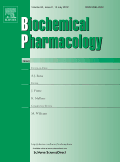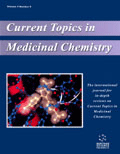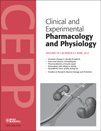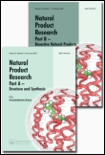
International Journal of Peptide Research and Therapeutics
Scope & Guideline
Advancing the Frontiers of Peptide Science.
Introduction
Aims and Scopes
- Therapeutic Applications of Peptides:
The journal investigates the use of peptides in various therapeutic contexts, including antimicrobial, anticancer, anti-inflammatory, and immunomodulatory applications. This includes the study of naturally occurring peptides, synthetic analogs, and engineered peptide constructs. - Peptide Design and Engineering:
Research published in this journal often focuses on the design, synthesis, and characterization of novel peptides. This includes the use of computational approaches, molecular docking, and structure-activity relationship studies to optimize peptide efficacy and specificity. - Mechanisms of Action:
The journal emphasizes understanding the biochemical and molecular mechanisms through which peptides exert their effects, including studies on signal transduction pathways, receptor interactions, and cellular responses. - Bioinformatics and Computational Modeling:
A significant portion of the research involves computational methods for predicting peptide interactions, designing peptide-based vaccines, and simulating the behavior of peptides in biological systems. - Natural Product Research:
The journal highlights the exploration of peptides derived from natural sources, including plants, animals, and microorganisms, and their potential therapeutic benefits. - Multidisciplinary Approaches to Peptide Research:
Research often integrates various scientific disciplines such as biochemistry, molecular biology, pharmacology, and materials science to advance the field of peptide therapeutics.
Trending and Emerging
- Antimicrobial Peptides (AMPs):
There is a growing body of research focused on the discovery, characterization, and application of antimicrobial peptides as alternatives to conventional antibiotics, particularly in addressing multidrug-resistant pathogens. - Peptide Vaccines:
The development of peptide-based vaccines, particularly in response to emerging infectious diseases such as COVID-19, has gained significant attention, with many studies exploring immunogenicity and efficacy. - Peptides in Cancer Therapy:
Research on peptides that target cancer cells, including their mechanisms of action and potential as therapeutic agents, is rapidly expanding, with a focus on novel delivery systems and combination therapies. - AI and Machine Learning in Peptide Design:
The integration of artificial intelligence and machine learning techniques in peptide design and optimization is emerging as a powerful tool, enhancing the ability to predict peptide interactions and therapeutic potential. - Natural and Synthetic Hybrid Peptides:
There is an increasing interest in hybrid peptides that combine properties of natural and synthetic peptides, aiming to enhance stability and efficacy for therapeutic applications. - Peptides for Neurological Disorders:
Research on the role of peptides in the treatment of neurological conditions, including neurodegenerative diseases and neuroinflammation, is on the rise, highlighting their therapeutic potential in the central nervous system.
Declining or Waning
- Traditional Antibiotics:
There appears to be a waning interest in the development of traditional peptide antibiotics as researchers increasingly focus on innovative approaches, such as multifunctional peptides or peptide-drug conjugates, to combat antibiotic resistance. - Peptides for General Health Supplements:
Research focused on the use of peptides exclusively for general health benefits or as dietary supplements is becoming less prominent, indicating a shift toward more targeted therapeutic applications. - Peptide-Based Diagnostics:
The exploration of peptides specifically for diagnostic applications has decreased, possibly as the field shifts towards integrated approaches that combine diagnostics with therapeutic interventions. - Basic Research in Peptide Chemistry:
While fundamental studies are essential, there is a noticeable decline in publications that focus solely on the basic chemistry of peptides without direct therapeutic implications, reflecting a trend toward more applied research.
Similar Journals

European Journal of Medicinal Chemistry Reports
Shaping therapeutic innovations with high-quality research.European Journal of Medicinal Chemistry Reports, published by ELSEVIER, is a vital platform dedicated to advancing the field of medicinal chemistry through open access communication of high-quality research. With an impact factor reflecting its growing influence, this journal has rapidly established a reputation for scholarly excellence since its launch in 2021. It serves as a converging point for innovative studies and reviews that span the disciplines of chemistry and molecular medicine, reflected in its Q2 and Q3 quartile rankings in relevant categories for 2023. Situated in France, the journal is accessible globally, ensuring that researchers, professionals, and students can easily engage with significant findings and methodologies in medicinal chemistry. The open access model facilitates the dissemination of knowledge, bridging gaps between laboratory research and practical applications in drug development. By fostering collaboration and highlighting emerging trends, the European Journal of Medicinal Chemistry Reports plays a crucial role in shaping the future of therapeutic innovations.

BIOCHEMICAL PHARMACOLOGY
Innovative research bridging biochemistry and pharmacology.BIOCHEMICAL PHARMACOLOGY, published by PERGAMON-ELSEVIER SCIENCE LTD, stands as a leading international journal devoted to the advancing field of biochemical pharmacology. Since its inception in 1958, the journal has continuously offered a platform for innovative research, delivering critical insights into the interaction between biochemical processes and pharmaceutical applications, and now converges towards its 2024 edition. With an impressive Q1 ranking in both Biochemistry and Pharmacology categories, it ranks 32nd out of 313 in Pharmacology and Toxicology, and 58th out of 438 in Biochemistry according to Scopus, showcasing its significant impact within the scientific community. Researchers and professionals rely on this journal to keep abreast of essential developments, given its robust peer-review process and a comprehensive selection of articles that span experimental studies, clinical trials, and theoretical analyses. Although not an Open Access journal, it remains pivotal for those seeking to advance their knowledge in the dynamic fields of biochemistry and pharmacology. With its high impact factor and emphasis on quality research, BIOCHEMICAL PHARMACOLOGY continues to be an invaluable resource for students, researchers, and industry professionals striving to make breakthroughs in drug development and therapeutic strategies.

BIOCHEMICAL AND BIOPHYSICAL RESEARCH COMMUNICATIONS
Unveiling the complexities of molecular life.BIOCHEMICAL AND BIOPHYSICAL RESEARCH COMMUNICATIONS, published by Academic Press Inc Elsevier Science, stands as a leading periodical in the fields of biochemistry, biophysics, cell biology, and molecular biology. With an ISSN of 0006-291X and an E-ISSN of 1090-2104, this esteemed journal has been a pivotal platform for the dissemination of groundbreaking research since its inception in 1959, continuing to publish influential findings through at least 2024. It holds a commendable Q2 ranking in Biochemistry and Q1 status in Biophysics as of 2023, reflecting its high impact and relevance in the field, supported by its strong Scopus rankings—ranking #43 in Biophysics and maintaining a presence in the top quartiles of several related categories. Although it is not an open-access journal, it provides critical insights and essential data that cater to researchers, professionals, and students keen on advancing their understanding of complex biochemical and biophysical processes. Its significant contributions to the scientific community underscore the importance of this journal as a reference point for innovative research and collaborative discourse.

Peptide Science
Bridging disciplines with cutting-edge peptide research.Peptide Science, published by Wiley, is an esteemed journal dedicated to advancing the understanding of peptide chemistry and its applications across various scientific disciplines, including biochemistry, biophysics, and organic chemistry. Since its inception in 2018 and continuing through 2024, this journal has provided an essential platform for the dissemination of innovative research, engaging articles, and critical reviews. With an impressive Q3 ranking in the fields of Biochemistry and Biomaterials, and a Q2 status in Biophysics and Organic Chemistry as of 2023, Peptide Science acknowledges its integral role in addressing significant scientific challenges. This open-access journal ensures that findings are readily available to a global audience, fostering collaboration and knowledge sharing among researchers, professionals, and students alike. The journal exemplifies excellence in scholarly communication, making it an essential resource for anyone interested in the intricate world of peptide research.

RSC Medicinal Chemistry
Connecting Disciplines for Breakthrough MedicinesRSC Medicinal Chemistry is a pivotal journal in the realm of medicinal chemistry, published by the esteemed Royal Society of Chemistry. With a focus on innovative research that intersects various disciplines such as biochemistry, drug discovery, pharmaceutical science, and organic chemistry, this journal serves as a vital resource for researchers, professionals, and students alike. Its impressive impact factor and notable rankings—positioning it within the Q1 and Q2 quartiles across critical categories—underscore its significance in advancing knowledge and fostering collaboration within the scientific community. RSC Medicinal Chemistry is dedicated to open access, ensuring that cutting-edge findings on drug design and therapeutic applications are freely available to enhance global research efforts. With a commitment to publication excellence from 2020 to 2024, it is a prominent platform where groundbreaking ideas meet practical implications, making it indispensable for anyone committed to the forefront of medicinal advances.

CURRENT TOPICS IN MEDICINAL CHEMISTRY
Exploring Breakthroughs in Therapeutic StrategiesCURRENT TOPICS IN MEDICINAL CHEMISTRY is a prestigious journal published by Bentham Science Publishers Ltd, dedicated to advancing the field of medicinal chemistry through the dissemination of high-quality research from 2001 to 2024. With an ISSN of 1568-0266 and an E-ISSN of 1873-4294, this journal is recognized for its significant contributions, as evidenced by its Scopus ranking in the 63rd percentile in the category of Drug Discovery, specifically at position #58 out of 157. Currently placed in Quartile 3 within Drug Discovery and Quartile 2 in miscellaneous medicine as of 2023, it serves as an essential resource for researchers, professionals, and students interested in the latest developments, methodologies, and applications in medicinal chemistry. The journal aims to foster collaboration and innovation by featuring original research articles, reviews, and brief communications that address current and emerging challenges in the discipline. Although it is not an open access platform, the journal's rich content is indispensable for those striving to enhance therapeutic strategies and drug development processes.

PROTEIN JOURNAL
Exploring the Frontiers of Protein ScienceProtein Journal, published by Springer, stands as a significant academic resource in the fields of Analytical Chemistry, Biochemistry, Bioengineering, and Organic Chemistry. Since its inception in 1996, the journal has dedicated itself to the dissemination of high-quality research focused on protein chemistry and its biomedical applications. With an impressive impact reflected in its classification as a Q2 journal in Analytical Chemistry and Q3 in both Biochemistry and Bioengineering as of 2023, it provides an essential platform for researchers and practitioners to share their findings. The journal embraces the open-access model, enhancing accessibility to cutting-edge research. The Protein Journal is crucial for academicians, industry professionals, and students, catering to their need for rigorous scientific discourse and innovative discoveries in protein studies. With an established track record of converging over two decades of knowledge and research, it continues to influence and shape the advancements in this vital area of science.

CLINICAL AND EXPERIMENTAL PHARMACOLOGY AND PHYSIOLOGY
Elevating Scientific Dialogue in Health ResearchCLINICAL AND EXPERIMENTAL PHARMACOLOGY AND PHYSIOLOGY, published by WILEY, is a premier journal that serves as a vital resource for researchers, professionals, and students in the fields of pharmacology and physiology. With ISSN 0305-1870 and E-ISSN 1440-1681, this journal has established itself as a significant contributor to scientific dialogue since its inception in 1974. Currently spanning until 2024, it consistently publishes cutting-edge research addressing both experimental and clinical advancements in pharmacology and physiology. Recognized for its quality, it holds a Q2 ranking in the 2023 Pharmacology category and notable Q3 rankings in both Physiology and Medical Physiology. The journal's coverage of topical issues not only ensures a robust platform for innovative findings but also fosters collaborations across disciplines. Although not an Open Access journal, its curated content is invaluable for advancing knowledge, as evidenced by its solid Scopus rankings, which place it within the top percentiles of its field. Engaging with this journal means staying at the forefront of research that shapes clinical practices and experimental methodologies.

NATURAL PRODUCT RESEARCH
Fostering Insights into Nature's Chemical WondersNATURAL PRODUCT RESEARCH is a distinguished journal published by Taylor & Francis Ltd, dedicated to advancing the field of natural product science through the dissemination of high-quality research. Established in 2003, this journal serves as a pivotal platform for scholars in Analytical Chemistry, Biochemistry, Organic Chemistry, and Plant Science, boasting an impressive categorization including Q2 in Plant Science and Q3 in the other disciplines for 2023. With a current Scopus ranking that highlights its significance within various scientific communities, NATURAL PRODUCT RESEARCH reflects the complexities and innovations associated with natural compounds and their applications. Researchers, professionals, and students will find valuable insights and breakthroughs that contribute to the understanding of bioactive compounds and their roles in health and environmental sustainability. Access options are available, ensuring that the latest findings are accessible to a global audience. As this journal continues to publish until 2024, it remains an essential resource for those at the forefront of natural product research.

Natural Product Communications
Advancing Research in Natural Remedies and BeyondNatural Product Communications is an esteemed open-access journal published by SAGE Publications Inc, dedicated to the exploration and dissemination of knowledge concerning natural products in diverse fields, including Complementary and Alternative Medicine, Drug Discovery, and Pharmacology. Since its inception in 2006 and continuing through its converged years until 2024, the journal has gained recognition with a robust focus on plant science and the medicinal properties of natural products. With a commendable impact factor reflected in its category quartiles (Q3 across key domains), Natural Product Communications serves as a vital resource for researchers and professionals who aim to further the understanding of the therapeutic potential of natural compounds. As an open-access journal since 2020, it ensures wide accessibility to its published research, thereby facilitating collaboration and innovation within the scientific community. This commitment to excellence makes Natural Product Communications a crucial platform for advancing research in the holistic and pharmacological sciences.